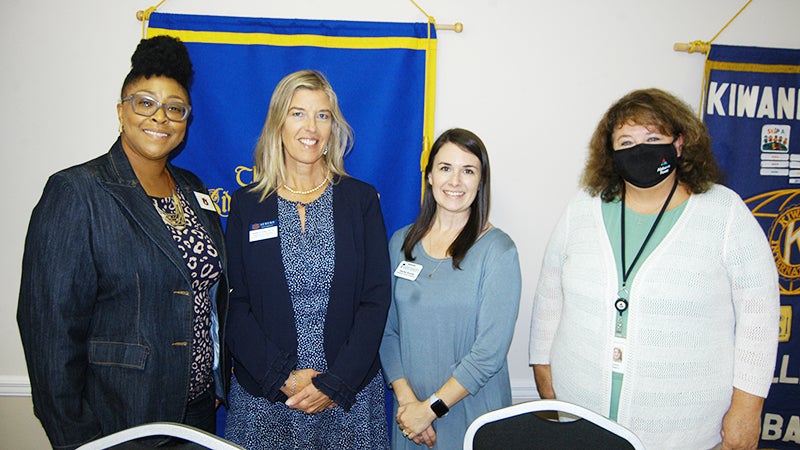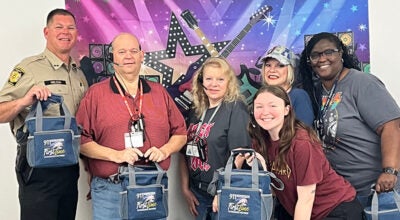Tele-Health station update given at Kiwanis Club of Valley
Published 11:00 am Saturday, October 9, 2021

- TELE-HEALTH update: An update on the new tele-health station was given at Wednesday’s noon hour meeting of the Kiwanis Club of Valley. From left, Dr. Chippewa M. Thomas, AU director of faculty engagement; Dr. Hollie C. Cost, assistant vice president, university outreach and public service, and Rachel Snoddy, director of the Chambers County Extension Office. At right is Karen Bennett, program chair.
|
Getting your Trinity Audio player ready...
|
VALLEY — Chambers County is on track to become the first location in Alabama to have a tele-health station. It’s a cooperative effort between Auburn University, the City of LaFayette and the Chambers County Commission. Officials believe the chances are good for getting a $400,000 grant to fund the initiative. Plans are to locate it in the former Vester clinic next to the Chambers County Department of Human Resources (DHR) off Highway 50 on the west side of LaFayette. The building will undergo some renovations, and if all goes well, it could open to the public sometime next spring.
Tele-health stations provide for virtual, life-sized, real-time encounters between a patient and a clinician. The clinician a local person is talking to is actually in Tampa, Florida, but for all practical purposes, it’s like they are there with them. It’s a means of modern technology providing a convenient, affordable clinician-patient connection resulting in quality care.
At Wednesday’s noon hour meeting of the Kiwanis Club of Valley, Dr. Hollie C. Cost, assistant vice president, university outreach and public service; Dr. Chippewa M. Thomas, director of faculty engagement and professor in the Department of Special Education, and Chambers County Extension Director Rachel Snoddy were present to discuss this ground-floor opportunity for a much-needed public health service.
“We looked at places all over the state to put this facility,” Cost said. “We settled on Chambers County because of the positive receptions we received from the LaFayette City Council and the Chambers County Commission. Chambers County has a good leadership structure and welcomed us with open arms.”
This rural health initiative involves a novel concept. The person going to the tele-health station enters a booth, presses a button and is in instant communication with a healthcare provider who is licensed by the state of Alabama. They have access to your medical records and will ask about general health. The station itself can dispense hundreds of common prescription medications with the approval of a clinician or pharmacist through a secure, robotically automated vault.
Cost said the tele-health station is not designed to take the place of primary care by a family physician, but it does offer a convenient means of having wellness checks at a cost comparable to a co-pay.
“Chambers County will be the first place in Alabama to have this, but we would like to extend it all across the state,” Cost said. “It’s an honor for me to be part of something like this.”
The tele-health station will be approximately seven feet wide, 11 feet long and nine feet high. It’s a glass enclosure that’s frosted for patient privacy. The first thing the patient does is to step on a scale to learn their current weight and body mass index (BMI).
“You then press a button, and a nurse practitioner comes up on the screen and asks you about your issues,” Cost said.
As a COVID precaution, the booth is thoroughly cleaned between each patient using an ultraviolet sanitizing procedure.
“We started discussing this last October and are now seeking a grant through ADECA,” Cost said. “If everything’s approved, we will install the tele-health station inside the existing building once the renovations are complete. Once we are ready to go, we will have public demonstrations on how to use it. We especially want to talk to senior adults who may not be comfortable with technology. We are thrilled to be able to offer this in Chambers County. We want it to be open at hours when it’s convenient for the patients.”
Tele-health stations can be set up almost anywhere, bringing health care via high definition video and audio to patients in rural areas. It makes real-time, virtual consultation with a nurse practitioner very convenient for those who may live a long way from healthcare providers.
A recent study revealed that as many as seven out of ten emergency room visits are unnecessary, as people are making visits for basic health needs, resulting in billions of wasted dollars and thousands of wasted hours in wait times. Tele-health stations make it possible for patients to be directed to receive immediate care for non-emergency needs, bypassing the ER altogether and freeing up resources.


